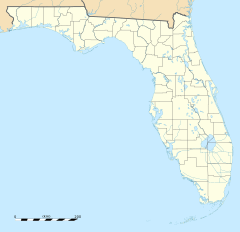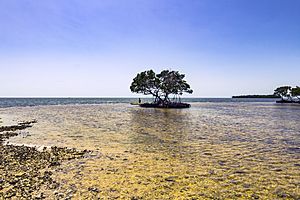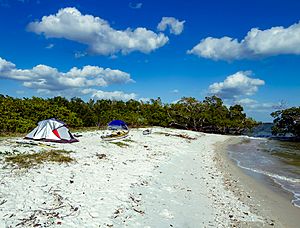Ten Thousand Islands facts for kids
Quick facts for kids Ten Thousand Islands National Wildlife Refuge |
|
|---|---|
|
IUCN Category IV (Habitat/Species Management Area)
|
|
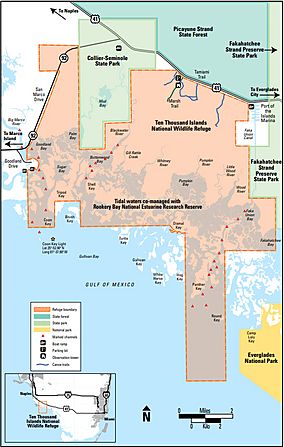
Ten Thousand Islands by U.S. Fish & Wildlife Service
|
|
| Location | Collier County, Monroe County, Florida, United States |
| Nearest city | Goodland, Florida |
| Area | 35,000 acres (140 km2) |
| Established | 1996 |
| Governing body | U.S. Fish and Wildlife Service |
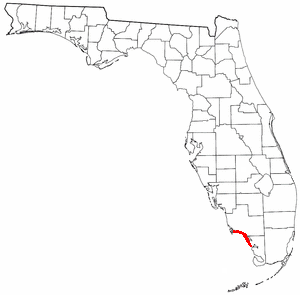
The Ten Thousand Islands are a group of islands and small mangrove islands (called islets). They are located off the coast of southwest Florida. You can find them between Cape Romano (at the end of Marco Island) and the mouth of the Lostmans River. Some islands are high points on a coastline that has been covered by water. Other islands grew from mangrove trees on oyster beds. Even though they are called "Ten Thousand Islands," there are actually only a few hundred.
Contents
Exploring the Geography of the Islands
The Ten Thousand Islands are split into two main parts. The northern part, from Cape Romano to Everglades City, is part of the Ten Thousand Islands National Wildlife Refuge. This refuge helps protect the wildlife and natural areas.
The southern part of the islands, south of Everglades City, is inside Everglades National Park. This park is famous for its unique wetlands and animals.
A long water trail called the Wilderness Waterway starts at Everglades City. It stretches for 99 miles and ends at Flamingo, which is at the southern tip of Florida. The islands are managed by two different counties: Collier County and Monroe County.
Discovering Ancient History: Archaeology
Native American people lived in the Ten Thousand Islands for thousands of years. You can still find signs of their old homes, some even under four feet of water. Many shell rings and other shell structures have been found here. These were built by the native people using shells.
One important place is the Horr's Island archaeological site. People lived there all year round about 3,500 years ago. Other ancient sites are thought to be underwater now because the sea level has risen over time. The way of life for the Native Americans in this area was special. It is known as a part of the Glades culture.
Who Lives on the Islands: Demography
Today, most of the Ten Thousand Islands do not have people living on them. The biggest island is Chokoloskee Island. It is connected to Everglades City by a road. About 400 people live there permanently. In the past, during the 1800s and 1900s, some other islands were home to individuals or families for short periods.
Fun Activities: Recreation
Some of the Ten Thousand Islands are great for camping overnight. The United States Fish and Wildlife Service decides which islands can be used for this. This area is a true wilderness. Things like strong winds, bad weather, and not having fresh water can make it challenging. Because of this, the Wildlife Service suggests that only experienced canoeists and sea kayakers try to make the trip.
Part of this island chain is within Everglades National Park. The park has officially named several islands where you can camp:
- Hog Key
- Turkey Key
- New Turkey Key
- Mormon Key
- Pavilion Key
- Rabbit Key
- Jewel Key
- Picnic Key
- Tiger Key
Stargazing in the Islands: Dark Skies Recreation
The Ten Thousand Islands are one of the best places left in coastal Southwest Florida to see a truly dark night sky. Pavilion Key is especially good for this. It is about 11 miles south of Everglades City. There are no city lights to the south of it. This natural, dark environment is perfect for stargazing and taking amazing pictures of the Milky Way galaxy.
See also
 In Spanish: Diez Mil Islas para niños
In Spanish: Diez Mil Islas para niños


